
The Westview School Blog
Cooking Up Connections: The Magic of Family Time in the Kitchen
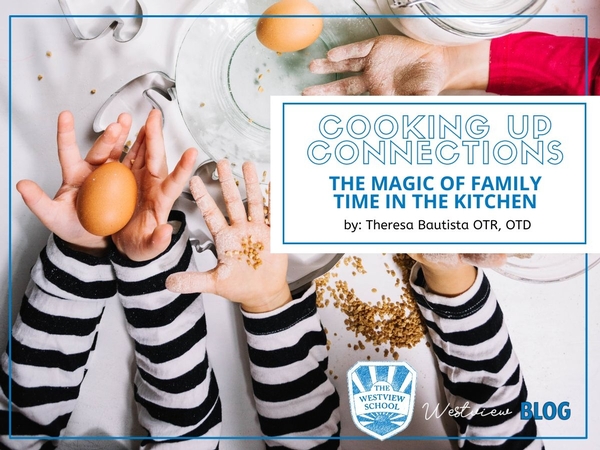
Parents are often looking for recommendations for fun family activities that could enrich their child’s life. Often, the best options can be found right at home.
Have you ever thought about involving your child in the kitchen? Activities such as preparing dinner, making a snack, or trying out a new recipe together can be a great start!
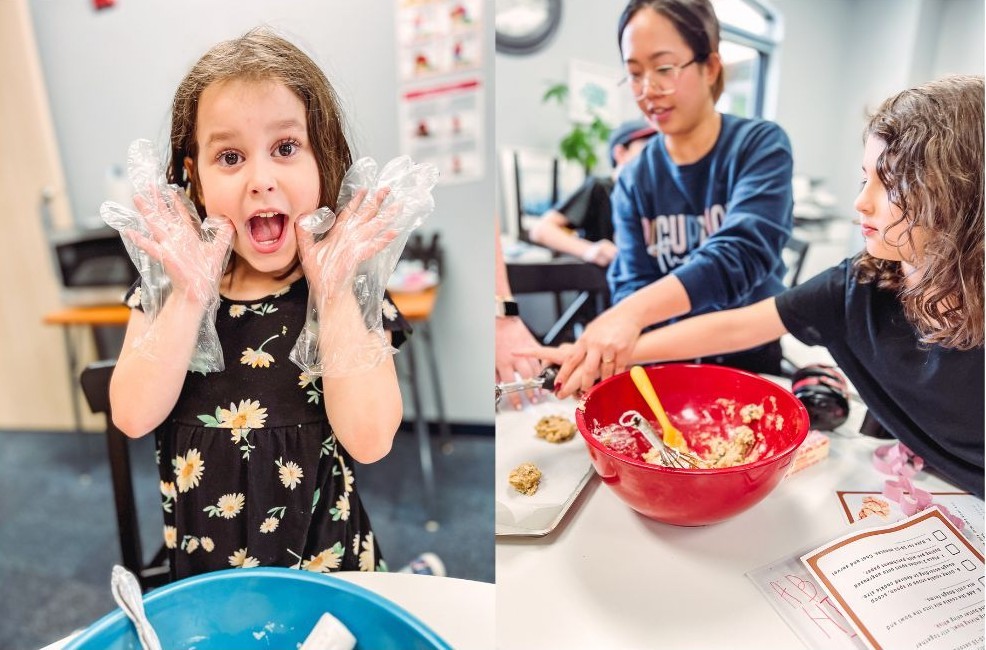
Cooking Skills and MORE
We all know that cooking teaches essential skills like measuring ingredients, following the sequence of steps in a recipe, and using various kitchen tools and equipment. Cooking provides an opportunity for children to learn how to handle utensils, chop vegetables, and stir batter. However, cooking offers far more than just the ability for your child to prepare meals for themselves and the family.
The kitchen is also an excellent place for sensory exploration – touching sticky textures (like dough) and experiencing various temperatures. Children with sensitivities to touch, taste, and smell, including those often described as "picky eaters," can benefit from this exposure, provided it allows them to explore at their own pace. This multi-sensory experience can expand their palate or help accommodate their specific support needs. For example, they may discover that wearing gloves can help their ability to handle certain textures.
The kitchen is not just a place for culinary adventures, it's also a classroom for safety. It's a perfect setting to teach children about the importance of being aware of extreme temperatures, sharp objects, breakables, and heavy items.
If you have concerns about kitchen safety, rest assured that there are kid-friendly tools like knives and scissors, non-slip cutting boards, and step stools available. You can gradually introduce them to heated tools, based on your and your child’s comfort level. This is also a great opportunity to demonstrate how to safely use the oven, stove, or air fryer.
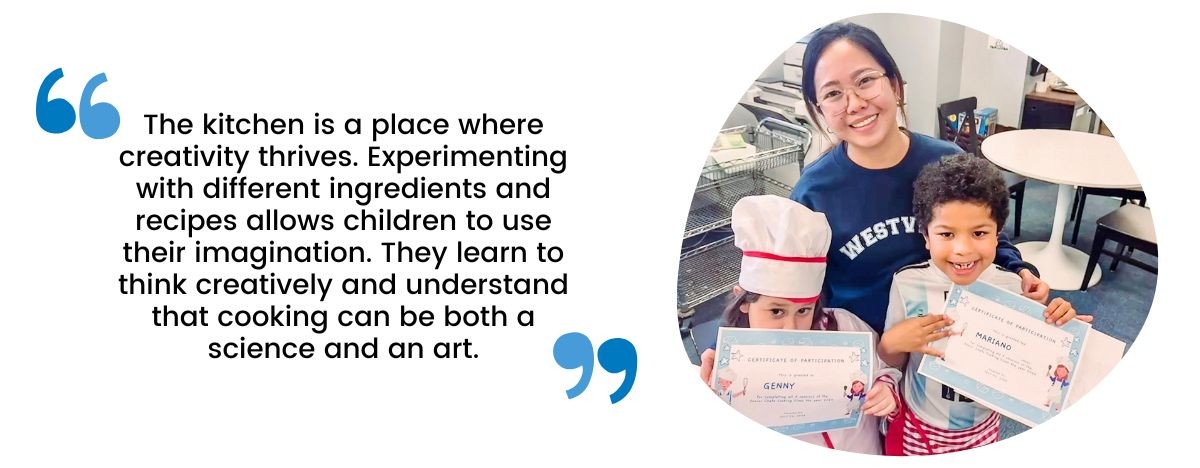
The Beauty of Cooking at Home
One of the best things about cooking with your kids in the kitchen is that you can make this a space for them to explore, make mistakes, and learn in a safe and familiar environment. When things get messy, spills happen, hands get sticky, or something breaks accidentally, allowing them to experience the natural consequences, teaches cause and effect. Initially, holding back immediate corrective feedback and allowing them to do it themselves allows them to learn and adjust. This approach builds their confidence and kitchen skills and reinforces your role as a trusted adult they can rely on for guidance.
These moments in the kitchen become cherished family stories, offering a chance to share the joy of creating something. Children witness firsthand how to communicate and how cooperation leads to a delicious end product. When families cook together, they learn to work as a team.
As children grow more comfortable in the kitchen, they gain independence. Learning to prepare meals for themselves is an essential life skill throughout their lifespan. The confidence they earn from these experiences extends beyond the kitchen and may contribute to overall self-esteem. If cooking is an accessible skill for your child, there are benefits to starting early and introducing them to the kitchen, especially if this is an area of interest.
By making cooking a shared family activity, you not only impart essential life skills to your children but also create a nurturing environment. So, roll up your sleeves, grab those aprons, and enjoy the many rewards of cooking together!
---
Theresa is a Registered Occupational Therapist with experience working with children, youth, and adults with neurological differences in the private school, clinic, and community settings. She received her Doctorate Degree in Occupational Therapy from The University of Texas Medical Branch at Galveston. Prior to becoming an occupational therapist, she worked in the field of Applied Behavior Analysis as a Registered Behavior Technician. She is also a writer and consultant who offers her specialized knowledge to websites and companies serving the neurodiverse community.
Visual Supports to Build Independence: Teacher Techniques That Transform Learning
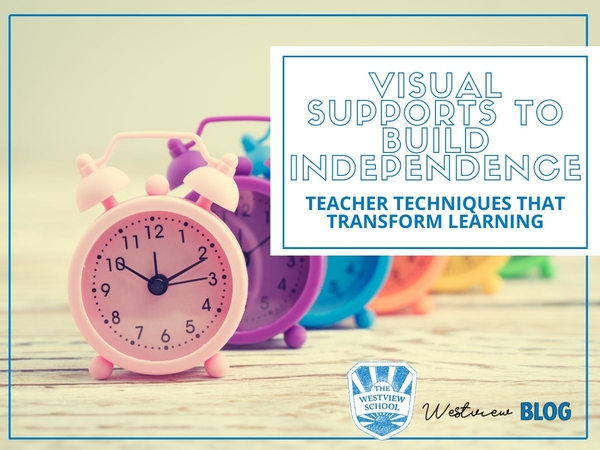
At The Westview School, we believe that fostering independence is a cornerstone of helping children with autism thrive academically, socially, and emotionally. One of the most effective tools in this journey is the use of visual supports. Visual supports use images, symbols, or cues to help students process information, communicate clearly, and navigate their day. Some examples of this include picture schedules, checklists, social stories, timers, and task cards.
From managing daily routines to enhancing emotional regulation and problem-solving, visual supports empower students with confidence and autonomy. Westview teachers and administrators integrate these strategies into their classrooms every day. Each approach reflects the creativity and dedication of Westview staffers to ensure every student has the tools they need to succeed.
Morning Checklists: Starting the Day with Independence
Christine Reilly, Lower Elementary Teacher
Executive functioning skills, such as organization and time management, can be challenging for children with autism. Visual checklists provide a structured approach to these challenges. In Lower Elementary, students start their day with a visual checklist displayed on the board detailing morning expectations. For example, a picture of a backpack represents hanging it on a hook. As the year progresses, these picture prompts are gradually replaced with words, and eventually, students complete tasks independently without visual assistance.
"This approach not only creates a predictable environment but also reduces anxiety and fosters a sense of accomplishment," says Christine Reilly. "Students feel confident knowing they can take responsibility for their morning routine."
Transition Cues: Easing the Shift Between Activities
Trevie Stone, Lower School Physical Education Teacher
Transitions, particularly away from preferred activities, can be challenging for many students. Leaving the motor room can often be a tricky transition. Visual timers, such as the TimeTimer™, paired with verbal countdowns, help students understand the abstract concept of time.
"I might say, 'We have five minutes left. What would you like to do before we leave?'" explains Trevie Stone. "Picture cards are another helpful tool. A small picture of the next activity or location can be a tangible reminder, helping students anticipate what's next."
The physical setup of the environment also supports transitions. Designated line-up spots and shoe cubbies act as visual cues for students, creating a smooth and predictable flow from one activity to the next.
Innovative Visuals for Younger Students
Amanda Warley, Prekindergarten Teacher
In Prekindergarten, visuals are everywhere—on the walls, at tables, and in task instructions. Amanda Warley recently introduced a portable photo printer to create instant visual aids tailored to her students' needs. "If a student prefers blocks over trains, we can immediately update our visuals to reflect that," she shares.
Amanda also uses visuals to prepare students for new experiences. For example, before practicing for the holiday program in a different building, she printed a photo of the location. “Having a picture helps students process what to expect, reducing anxiety. These personalized visuals make all the difference in fostering understanding and comfort.”
Step-by-Step Task Cards: Building Independence in Learning
Serena Gaylor, Middle School Language Arts Teacher
Breaking down tasks into manageable steps fosters independence and encourages self-assessment. "In my classroom, students always have a 'to-do' list and an 'after I'm finished' list displayed on the screen," says Serena Gaylor.
Recently, during a poetry unit, students followed a criteria-based checklist to evaluate their work. "This allowed them to independently assess their poems, identify areas for improvement, and ask more specific questions," Serena explains. "Step-by-step guides give students the tools to take ownership of their learning and build confidence in their abilities."
Visual Supports for Emotional Regulation
Sally Schwartzel, Lower School Principal
Visual supports also play a vital role in helping students manage their emotions. Tools like visual schedules, checklists, and social narratives provide clarity and predictability, reducing anxiety. "When students know what to expect, they feel more in control of their day," says Sally Schwartzel.
For emotional regulation, visuals can help students identify their feelings and choose appropriate coping strategies. “If a student feels frustrated, visual supports remind them of what they can do—like taking deep breaths or asking for help. This empowers them to navigate challenging moments with greater confidence.”
Empowering Students Through Visual Supports
Visual supports are more than tools; they are bridges to independence, confidence, and self-advocacy. At The Westview School, we take pride in using evidence-based practices to meet our students' unique needs. By integrating creative and personalized strategies, our educators ensure that every child can shine in their own way.
Want to see these approaches in action? Visit our website or connect with us on Instagram and Facebook to learn more about how we are empowering our students every day.
From Tantrums to Triumphs: Behavior Strategies at Home and Beyond

Understanding behavior, whether at home or in the community, can feel overwhelming, but it all boils down to one simple fact: behavior is just any measurable action. In this blog post, Sally Schwartzel, Lower School Principal at The Westview School, shares practical strategies for managing behavior by focusing on what we can control—our own actions. From offering choices to teaching replacement behaviors, these insights help parents create more positive interactions with their children. This post was adapted from her presentation for September WestviewEDU.
Behavior: It Is What It Is
When thinking about behavior in the home and community, there are many topics to cover – everything from self-help skills to attending a group function with peers. However, this wide range of topics can all be addressed by looking at behavior for what it is. It’s just behavior! Behavior is any measurable, observable action. Behavior is anything from waving hello to someone to hitting a friend.
The most important thing to remember is that we cannot change the behavior of others. This can be SUPER frustrating! BUT, there are things that we can change. Changing what we are doing, in turn, will change the behaviors of others. To figure out what to do before or after, we need to know “Why” the behavior is occurring. The “Why” is also called the “function” of the behavior. Don’t worry – there are only two main reasons why behaviors occur. PSA: This applies to all people, not just our kids. All of us exhibit behaviors (positive or negative) because we obtain or escape something. Many times, we work for a paycheck (obtain). We also push the snooze button on an alarm – to escape the noise… and the waking up part! To change behavior, we have to change what happens before or after it happens – which is something we can control.
Changing the Before and After
So, what can we do before a behavior happens to prevent it? My favorite is offering a choice – with a catch. The choice isn’t “Are you ready to do your homework?” The choice is “Do you want to do your homework now? Or do you want to do your homework in 5 minutes?” This gives the option to make that choice - but within your parameters. My second biggest recommendation is to frontload expectations. Give your kids a visual schedule or a checklist. Set up a routine. The more our kids know what to expect, the fewer surprises for everyone involved! Think about what a “to-do” list does for you... the schedule/checklist is their “to-do” list!
What about after a behavior occurs? If a person is still exhibiting a behavior, they are either obtaining or escaping something. For example, if a child throws a tantrum in line at the grocery for a candy bar and gets a candy bar, next time, it’s really likely that the child will throw a tantrum again. If a child rips up their homework and doesn’t have to complete it, it will likely get ripped up again. To break that pattern, we need to change what happens after. We can power through the line at the grocery store with the child kicking and screaming. We could have extra copies of the homework or ask for a laminated copy that can’t be ripped. Seems easy enough, right? WRONG. Sometimes, the tantrum in the line in the grocery store is too big. Sometimes, the ripping of homework after a long day is the final straw at the end of a really long day. The missing piece is teaching our kids what to do instead of the challenging behavior.
Teaching Replacement Behaviors
The “what to do instead” is called a replacement behavior. Replacement behaviors get our kids what they want (or don’t want) in a more appropriate way. If we set the expectation at the grocery store as “If you do not throw a tantrum and you ask for a candy bar,” you will get it. If, during homework time, the expectation is that the child can ask for a break or ask for help, that is a much better behavior than ripping it up.
You’re probably thinking, “So I have to let my child get a candy bar every time? Or let them not do their homework?” The answer is… well, kind of. This is only in the beginning while you are teaching those replacement behaviors. Once the child learns they do not need to exhibit those inappropriate behaviors, you can start taking steps back or fading support. For example, the new expectation is “If you do not _____, you can get a snack this time in the line and a candy bar next time.” The expectation can be set at the beginning of the grocery store trip that a candy bar isn’t an option this time, but these three different yummy snacks can be asked for. When it comes to homework, maybe the child needs to write their name on the homework before asking for a break. If the child learns to ask for help, maybe you give them the answer to the first part and then have them complete the rest on their own.
Simple Long-Term Tips for Success
Behavior is so easy and so complicated at the same time. The best advice I can give (learning from different parents throughout the years) is to do what you must to keep your sanity. Tip for doing that and still working behavior to your advantage? Having your child comply with the tiniest directive before giving them a preferred item or activity will save your life in the future. I have had some parents, in order to keep their sanity, have their child simply push in a chair, clear a dish, etc. before iPad time. It seems so small, but it will really help out in the future!
Sally Schwartzel is the Lower School Principal at The Westview School. She brings a wealth of knowledge and experience to The Westview School, having worked for over 18 years in Katy ISD as a special education teacher in specialized autism programs and then as a leader at the district level for autism and behavioral programming. She holds a Master’s Degree in Special Education with a focus on Autism and Developmental Disabilities from The University of Texas. She is a Certified Teacher and a Board Certified Behavior Analyst. She has co-authored and co-presented on relevant topics such as Positive Behavior Interventions and Supports and Autism Support and Intervention Program.
This blog post was adapted from the presentation given during WestviewEDU on Thursday, September 5, 2024. WestviewEDU is an education series presented by The Westview School for parents and caregivers of children with autism spectrum disorder. For a full list of WestviewEDU sessions for the 2024/2025 academic calendar year, visit The Westview School online.
Executive Functioning: Air Traffic Control for Your Brain!
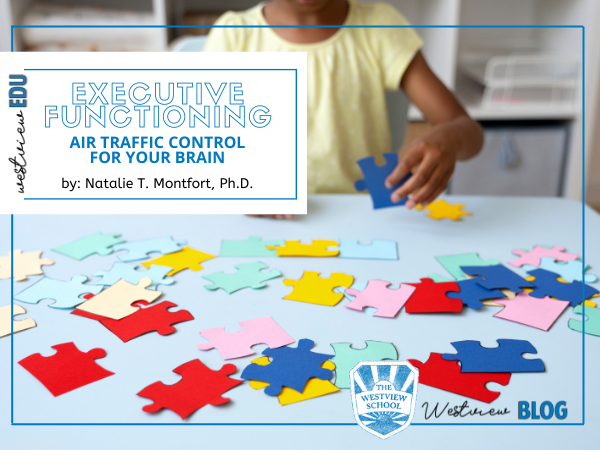
Do you know people in your home or classroom who always lose their belongings, forget important items, get lost from the kitchen to the bedroom, run chronically late, or just generally seem like a "mess?" Weak executive functioning could be to blame!
Executive functioning is a general term that refers to our mind’s mental manager or the cognitive processes that regulate our thinking and behavior. While there are many models of executive functioning, most include the individual’s ability to generate ideas, initiate or begin a task, stick to and finish a task, flexibly problem-solve, shift from one idea or topic to another, inhibit our impulses, ignore distractions, regulate attention, regulate our behavioral and emotional responses, use feedback to guide future behavior, select relevant goals, organize materials, hold information in mind until needed, and more. I like to think of our executive functions as air-traffic control for our brain or as the conductor of the mind’s orchestra.
When all is well, cognitive processes flow smoothly, and behavior fits the situation as expected. When there are problems… well, just imagine the airport with poor air-traffic control! Executive functioning is needed for all aspects of life. Socially, we need executive functioning to help us regulate our behavior and emotions when we are upset. After all, throwing the board game when we are losing is frowned upon…, particularly in adolescence or adulthood! We spend a great portion of time controlling our impulses to speak out in school or a meeting, to refrain from spending too much money, or even overeating. Executive functions help us to arrive on time, prepared, and with a plan for how to behave. They are also critically important for academic success. Not only are executive functions needed for decoding written text, reading comprehension, solving math word problems, and long division, but they are also needed to be an organized, efficient student who remembers homework and can plan for projects and tests. These days, if you are not in the right place, with the right things, at the right time, it is difficult to be a good student, no matter how bright you are! In fact, being in the right place, with the right things, at the right time is the very basis of holding a job.
When there is executive disfunctioning, life may feel chaotic or unproductive. The child or adult may experience social, academic, or employment difficulties and/or problems in the home. The good news is that executive functions are thought to be able to be developed or strengthened. These skills begin developing in infancy as babies learn to wait to have their needs met. They really come ‘on board’ in the brain around age two as children learn they are active agents in their own world. Beyond that age, executive functions are thought to keep developing into young adulthood. Just as they can be strengthened, executive functions can be weakened or damaged. Neurological insults from accidents, injuries, or other sources can impact executive functioning temporarily or long-term.
Executive dysfunction is often part of the presentation of neurodevelopmental disorders such as Attention-Deficit/Hyperactivity Disorder, Autism Spectrum Disorder, and Specific Learning Disabilities. Although executive functioning is thought to be the most impaired in the aforementioned conditions, it is also implicated in conditions such as anxiety, depression, and even medical conditions such as low blood sugar. Problems with executive functioning are often what bring families to seek help from psychologists, psychiatrists, or doctors.
Understanding the importance of executive functioning is the first step to facilitating its development. The ‘Practice Makes Perfect’ principle applies here. If a child has no experience planning for their day or organizing their materials, it is unlikely that he or she will simply arrive at this skill in high school.
From the time they are small, children should be encouraged to help with planning and organizing. A toddler may not be able to make a sandwich, but they can help pack a lunch. Likewise, a young child who cannot do their own laundry can sort laundry or help pick out clean clothes for tomorrow.
Children can also help with the planning and preparation for parties, events, and projects. Learning how to react when what we want is not available, what to do when we forget something important, and how to persist with the temptation of distractions are all valuable skills that adults need to afford children. Children can have fun while they help adults with household tasks and learn these skills. They can also work on these skills in their play.
Childhood games have been shown to improve the executive skills of preschool children. Games such as Simon Says, Red Light Green Light, and Mother May I all help children to practice attending, inhibiting impulses, problem-solving, regulating behavior, and regulating emotions. For older children, yard games such as Freeze Tag and Capture the Flag can be helpful. Board games are also great ways to develop flexibility, inhibition, problem-solving, and shifting. Some favorites for young children are Candy Land and Chutes and Ladders. These games are great for teaching flexible thinking by changing the rules. Some fun examples are to play the board backward or try to be the last one to cross the finish line! For older children, strategy games such as chess, Chinese checkers, or Risk may be helpful. Children and adults also tend to enjoy German-style or Euro board games. These games tend to minimize conflict and luck and emphasize problem-solving strategies. Some popular examples are Ticket to Ride, Settlers of Catan, Small World, and Dominion. These games require planning, problem-solving, shifting strategies, and many other executive functions to master despite relatively easy gameplay and moderate playing times.
In addition to practicing executive functioning skills throughout life, accommodations and supports for weak executive functioning are often helpful. For example, making lists, using sticky-note reminders, using alarms, and having organizational systems in place can help support executive functioning skills. There are several books available with excellent strategies for support. Some of my favorites are: Smart but Scattered: The Revolutionary “Executive Skills” Approach to Helping Kids Reach Their Potential by Peg Dawson and Richard Guare; The Explosive Child: A New Approach for Understanding and Parenting Easily Frustrated, Chronically Inflexible Children by Ross Greene, PhD; and The Asperkid’s Launch Pad: Home Design to Empower Everyday Superheroes by Jennifer Cook O'Toole.
Executive functioning skills take effort and experience to develop over time. Many services and providers exist for families requiring guidance to facilitate growth in their loved one’s executive functioning. The Stewart Center at The Westview School offers individual therapy to facilitate executive functioning in adolescents and adults, group therapy for fun skill-building in children, as well as parent coaching and case management to assist families in promoting these skills in their daily lives at home. For more information, contact 713-973-1842 or info@stewartcenterhouston.org.
--
Dr. Natalie Montfort is a licensed clinical psychologist with Montfort Psychology Associates. Dr. Montfort has over 20 years of experience working with children and adults with ASD and has training in Cognitive Behavioral Therapy (with children, adolescents, and adults), Trauma-Focused Cognitive Behavioral Therapy, Relationship Development Intervention, Social Thinking, behavior modification (including Applied Behavior Analysis), and education/educational assessment. Dr. Montfort graduated summa cum laude and as valedictorian of the College of Liberal Arts and Sciences at the University of Houston with a Bachelor of Science Degree in Psychology. She earned a Master of Arts Degree and a Doctor of Philosophy Degree in Clinical Psychology from Fielding Graduate University. Dr. Montfort completed her doctoral internship with the University of Texas Health Science Center at Houston’s Department of Psychiatry and Behavioral Sciences and her post-doctoral fellowship at The Stewart Center at The Westview School. She obtained licensure as a Clinical Psychologist in 2016, and she and Dr. Ken Montfort launched Montfort Psychology Associates in 2020. Her areas of interest include assessment of children, adolescents, and adults; cognitive and behavioral differences in children with neurodevelopmental disorders; treatment of adoption-related issues; treatment of childhood trauma; and animal-assisted therapy. She also enjoys providing professional development, trainings, and lectures on these and other topics to a wide variety of audiences.
This blog post was adapted from the presentation given during WestviewEDU on Thursday, September 1, 2022. WestviewEDU is an education series presented by The Westview School for parents and caregivers of children with autism spectrum disorder. For a full list of WestviewEDU sessions for 2022/2023 academic calendar year, visit The Westview School online.
The Experts' Guide to Picky Eaters

Are mealtimes a battle? Does your child have a limited food repertoire or only eat one brand of food? Desperately seeking tips for a successful family mealtime? The Stewart Center has some Picky Eater experts on staff to share their favorite tips and best practices from hands-on experience working with some of the pickiest eaters and their families.
The first question many families ask is: Who can help? Eating is a multisensory experience. As adults, we forget the many factors involved in eating because it is such a routine task for most of us, but eating is a surprisingly complex process. Both speech and occupational therapists can play an essential role in supporting positive change in even the pickiest of eaters.
Abby Cook, M.S. OTR, and Alexandra (Ali) Nevins, M.S., CCC-SLP are part of The Westview School's Stewart Center team and are trained in the S.O.S. Approach to Feeding®. This approach is a sensory-based feeding intervention that moves students through a hierarchy of exercises designed to increase tolerance of various foods. The S.O.S. Approach to Feeding® was developed by Dr. Kay Toomey over 30 years ago. Her program has a high success rate in the diversification of diets of picky eaters.
Because eating uses every sensory system, from visual and tactile to vestibular and interoception, a multisensory approach to feeding therapy is the start to a recipe for success. Pun intended. The Stewart Center therapists are trained in evaluation and assessments and the facilitation of individual and group feeding therapy.
When it comes to feeding therapy, a speech therapist, like Ms. Ali, can assess and support the development of a child's oral motor and feeding skills, mechanisms of chewing and swallowing, oral motor structure as well as protecting the airway during the swallow, biting, and chewing phases of eating.
An occupational therapist (OT), like Ms. Abby, can help to develop a child's fine motor skills and coordination needed to move food from plate or hand-to-mouth. Skills such as grasping, utensil use, postural control, and musculoskeletal strength for positioning during eating are necessary for successful feeding. An O.T. can also observe and assess environmental factors, modify or make changes to support optimal focus and attention to eating. Both speech and occupational therapists will consider all of these factors when working with children with food aversions to identify how to best help an individual child.
Today, we want to offer some quick tips that you can implement at home now. When dealing with a picky eater, it is essential to examine three things – the environment, language, and behaviors we model. Start with a quick check by asking yourself these questions:
- Is there a smell or taste that is overwhelming or underwhelming to your child?
- Is the environment overstimulating?
- Is there background noise during mealtimes, such as television or music?
- Does your child have the opportunity to watch a sibling or parent eat and model typical feeding behaviors?
- Can your child manipulate a utensil successfully?
- Do you find yourself saying two more bites, and then you can go (i.e., play, watch tv, or play the IPad).
Try these tips to skip those mealtime battles and help your kiddo expand their palate and self-feeding skills.
Set Up for Success: Check Your ENVIRONMENT
- Seating tops the list of important environmental factors for a successful mealtime. Think 90-90-90. Hips, knees, and elbows should be at 90-degree angles while seated for eating. Stick to a sturdy chair or highchair at the table.
- Provide appropriately sized utensils at mealtime, and use fun phrases to initiate utensil use during mealtime like "Catch the food on the fork."
- Keep food portions small – especially with new foods. The new color, smell, or texture may be overwhelming! Always provide at least one familiar food item for your child to eat. Make sure to have some new options to try exploring, but a safe food should be just that - one that feels "safe."
- Keep regular mealtime routines to lower stress and keep expectations clear for everyone.
- Have your child throw away their uneaten food items in the trash. This gets them one step closer to interacting with food, even if it is to throw it away.
- Limit both visual and audible distractions during mealtime. Television, music, and iPad can detract from your child's ability to observe typical eating and self-feeding.
- Model it! Eat meals together as much as possible. Children need to see visual models of typical eating behaviors.
Hungry for LANGUAGE. While your focus may be on what should be going in your child's mouth, what comes out of yours matters just as much.
It might be time to flip the script if you have said one of the following to your picky eater: "Clean your plate." "You have to take two bites to leave the table." "Good job eating that." "Finish your food before (i.e., T.V. or Dessert)." These phrases can unwittingly up the anxiety during mealtime.
Instead, use some alternate words/phrases that keep mealtime stress-free and fun.
- In response to, "I'm not going to eat that!" ask, "What can you do with the cheese stick?" It helps to give an example: "Can you make a mustache or wiggle it like a wobbly worm?"
- "What can you catch on your fork?"
- "Does that food have a big flavor?"
-Encourage your child to say, "I'm still learning about that." instead of "I don't like that!"
Your mother may have said, "Don't play with your food!" but when it comes to a picky eater, it might be time to change your BEHAVIOR around eating.
- Model eating and be PLAYFUL! Make food fun! Make it ok to "play" with your food. Parents can model food interactions that go beyond simply eating; encourage play during mealtime. Some examples of play can include: placing food on body parts, making a noodle into a worm, using crackers to build a sandwich, digging for gems in jello or pudding, and using food as a mustache or a long tongue.
- Avoid forcing your child to take a bite or a drink of something. This sets up an unwinnable power struggle.
- Avoid tricking your child with foods or beverages. As therapists and parents, we need to build and maintain a child's trust-related to food and drinks. When we "sneak" a new vegetable or drink into a familiar dish or a preferred cup, it can disrupt trust and turn a child off from a preferred food altogether.
We hope that these tips help you gain confidence and avoid some pitfalls at mealtime with your picky eater. If you want to learn more about Individual or Group Feeding therapy, please reach out to The Stewart Center. Our team is passionate about working with our picky eaters, supporting their families, and having fun with food.
If you are interested in learning more, contact The Stewart Center at 713-973-1830.
Additional Resources:
Instagram:
@kids.eat.in.color
@sosapproachtofeeding
@solidstarts
Websites and free resources:
sosapproachtofeeding.com/start-here-parents/
www.solidstarts.com
Parent & Caregiver Workshop (Free Full parent workshop video)
Learn from Dr. Toomey (the founder of the SOS Approach to Feeding) about why children don’t eat well and practical strategies for improving mealtimes in your home through the introductory video “When Children Won’t Eat (and how to help!).
--
Alexandra (Ali) Nevins, M.S., CCC-SLP is a Licensed Speech-Language Pathologist with the Texas Department of Licensing and Regulation and obtained a Certificate of Clinical Competence through the American Speech-Language-Hearing Association. Ali completed her Bachelor of Applied Science Degree from The University of Mississippi and received a Masters of Science in 2018 from Yeshiva University at The Katz School. In New York City, Ali worked as a clinical extern in the school system as well as at New York Neurogenic Speech-Language Pathology, P.C. Ali has been working full-time as an SLP at The Stewart Center at The Westview School since 2018. She has received continuing education training in SOS Approach to Feeding ® and Social Thinking ®.
Abby Cook, M.S., OTR is a Licensed Occupational Therapist with the Texas Board of Occupational Therapy Examiners and obtained certification through the National Board for Certification in Occupational Therapy. Abby completed her Bachelor of Arts degree in Psychology and Family Studies at St. Olaf College in Minnesota, and received a Master’s of Science in Occupational Therapy from the University of New England in Portland, Maine in 2017. Once in the Houston area, Abby started her OT career in Early Childhood Intervention for Brazoria County and has been full-time with the Stewart Center at The Westview School since 2018. Her continuing education training includes SOS Approach to Feeding ® and introductory coursework in The DIR/Floortime Approach®.
